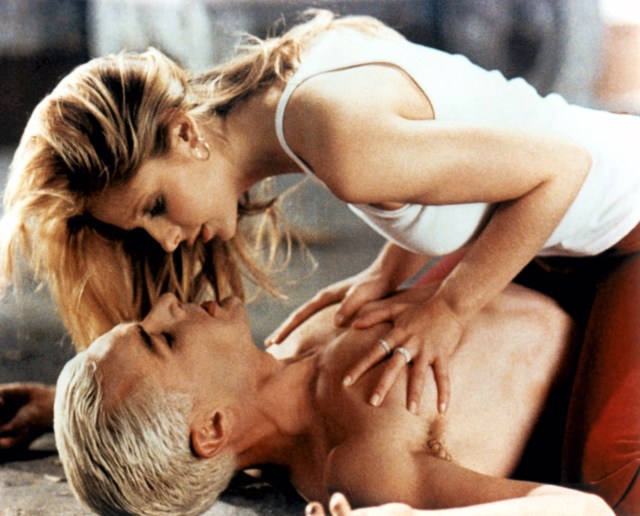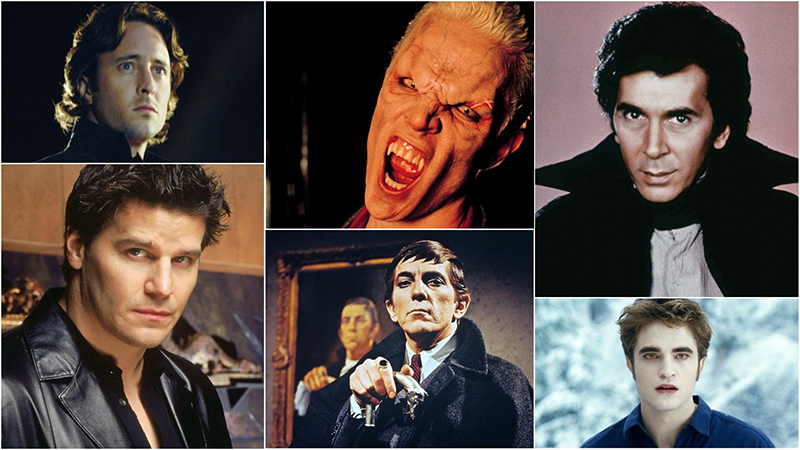Frank Langella as Dracula

In 1979, American born actor Frank Langella took his Broadway role of Bram Stoker’s Dracula and transferred him to the big screen in a film directed by John Badham. Although there’s no shying away from what Dracula is, there is an emphasis on the romance between him and Lucy Seward (Kate Nelligan) — and the fact that he will allow nothing to interfere with it.

His Approach: “I did not go back to look at the old Draculas. I felt that I had to find a way that would make him work today. I came up with an erotic and vulnerable man who is lonely and can fall in love. I never saw him as a guy dripping blood all the time. Basically, I went in trying to hold on to the inner core of the character as best I could.

“Dracula is not a ghoul. I decided to play him as a lonely, troubled monarch with a sense of humor and a unique social problem. I see him as a noble man with a quiet secret. Not a man who goes around attacking victims, but instead seduces them. He is compelled to drink the blood of innocent victims.”
Ben Cross as Barnabas Collins

In 1991, NBC briefly aired a prime time version of Dark Shadows, which was a one-hour weekly show that retold the early Barnabas storyline from the soap, but in a much quicker fashion. Playing the character was British-born Ben Cross, best known at the time for his role as Olympic athlete Harold Abrahams in Chariots of Fire (1981).

The Appeal of Barnabas Collins: “I think one of the first things is the way women might view a vampire and vampire tale is somewhat different to the way a man would. The series gets to a certain point where we simply have to go back to the past and find out exactly what went on. So we see Barnabas as this really very nice guy. Very happy family, and it’s really like a cautionary tale for married men. He actually has a fling with the wrong person, and the phrase of hell having no fury like a woman scorned is absolutely true, because, in fact, she comes from hell. In a sense he makes a human mistake that a lot of people, if they’re honest, have actually made. He regrets it, and then becomes a victim and a vampire. In a sense, he is as much a victim of his own condition in the way that the people he finds himself biting.

“I was asked if each week would be self-contained; episodic with a beginning, middle and an end. The answer is no. I was not going to be interested in any way, shape or form in that kind of series about a vampire. I feel that there were much more interesting areas. It’s more like a psychological study. An exploration of the whole mythology of vampires. When I was satisfied that it was going in that particular direction, it was fairly easy for me, because it’s an extraordinary story and an extraordinary character. And I can promise you I’m not exaggerating when I say it’s really one of the most challenging roles I’ve ever played, because I have to come up with something new every episode.”
James Marsters as Spike

James Marsters was introduced in the second season of Buffy the Vampire Slayer as Spike, a former companion of Angelus (before he became Angel — see the entry on David Boreanaz for more) who was initially designed as a “big bad,” but he evolved over the course of the series. He became Buffy’s ally and eventually her lover after she came back from the dead (too detailed to get into here), ultimately regaining his soul and sacrificing his life to save the world.. until he was resurrected for the final season of Angel.

Approaching Spike: “I did some research into being a soldier and I found someone saying that one of the things that soldiers can’t talk with civilians about is the fact that murder is fun. There’s a rush that happens when you take a life. There’s a sense of power to that. And one of the things that soldiers have to deal with for the rest of their lives is the guilt they feel having felt this animal reaction. Civilians really don’t understand when you talk about it. Luckily, I had already played a role where I became comfortable and didn’t feel guilty about this rush of excitement, imagining doing that act.

“When I took on the role of Spike, there’s a saying in theater: it’s called a play for a reason; no one pays to watch you work. They’ll pay to watch you play really well. And so, it’s always about fun. You have to have fun in what you’re doing. It seemed the way to make Spike work was just have this guy having the best time doing the most vile acts, and that’s just sick. Horrible. But if you can give yourself over to it, it can be a wild, weird ride for the audience. I was able to give myself over to that. And once you do that, you’re just through the looking glass. You’re just in new territory. Spike asked me to enjoy the sadism. That was probably the most enjoyable part of it initially. The character grew way beyond that. But the first rush was that.”

Keeping Spike Alive: “Initially, the idea was that Angel and Buffy were going to have sex, at which point Angel goes evil as many boyfriends do in real life. And Angel would kill Spike, thus becoming the big bad. That was the original plan. And they kept most of that, but then didn’t kill me off. It let Joss kind of explore Spike as the sidekick — as the jealous little brother, rather than the Big Bad that originally came to Sunnydale. Once you decide not to kill Spike off, the problem is how do you get him up off that ladder of cool and back down to Earth so he can actually be explored as a three-dimensional, interesting character? I think ultimately what they came up with was that Spike was the most successful poser in the history of the world. Like most people who want to seem tougher than they are, they just buy some leather pants and the right car or whatever. But Spike actually was made into a vampire so that he could get away with posing. Because he was super strong and could heal quickly and all of that stuff, he actually could pose and get away with it.”

On Spike Developing Romantic Feelings For Buffy: “My idea was that Spike should fall in love with Buffy. Of course she never reciprocates, because he’s way beneath her, but he should fall in love with her and he should try to be good and constantly fail, to comedic effect or to horrifying effect, whichever episode you’re doing. But you can go a lot of directions with that. That wasn’t their idea.”
Spike Sacrificing Himself to Save the World in the Final Episode: “My final scenes were done on second unit . There had already been tearful speeches made about how we began and how we got through it, but that was all in the scene with the Scooby gang [Buffy and friends], so I didn’t have that. But there was something that was kind of right about that, because I never really fit into the gang on screen and that had a reflection in life, too.
“Spike had no idea he was going to be the big hero. He just wanted the freaking necklace that would stop the apocalypse. He just didn’t want Angel to have it and he was just proud that he got it and not Angel. It was just very petty on his part and the things starts glowing and he lights on fire and he’s, like, ‘What the f… oh, no!’ I played it as it wasn’t a big heroic act.”

Joining the Cast of Angel In Its Final Season: “One of the great things about going over to Angel was that I could just be the dick again, like I had been on Buffy in the early years. I could just be the jerk and try to give Angel a headache on a daily basis. My intent joining the show was to make life as miserable as possible for Angel. I just absolutely wanted to be pitted against him; to have to work with him and hate him anyway was absolutely hilarious. Spike functions well with an enemy or someone he can be surly to. David Boreanaz plays that really well, too. I don’t know if it’s about good or evil. Even if Spike’s good, he hates Angel anyway, because Buffy could obviously never get over him. And Angel would hate Spike, because he’s been with her. The dynamic was set up for some delightful conflict between the characters.”
